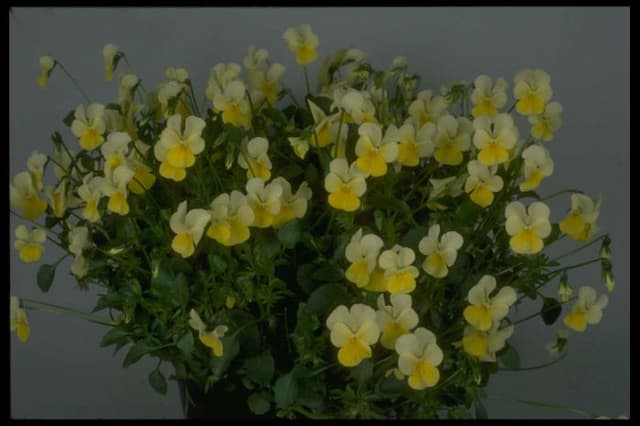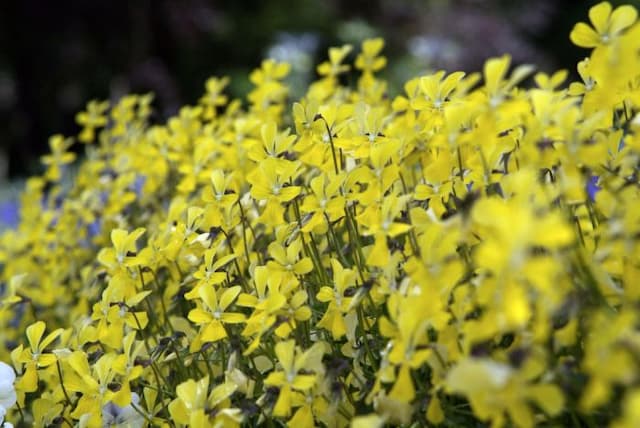Corsican Violet Viola corsica

ABOUT
Viola corsica, commonly known as the Corsican violet, is a plant that displays a remarkable profusion of flowers. It bears a close resemblance to the common wild violets seen in the woodlands, but its individuality stands out through its unique petal shapes and colors. The Corsican violet typically showcases a blend of purple and violet hues, sometimes with streaks or patterns that add to its visual appeal. The structure of the flowers is characterized by a symmetrical arrangement, where the lower petals gracefully extend outward from the center. The leaves of the Corsican violet are as distinctive as its flowers. They possess a lush green color, and generally, their shape is somewhere in the spectrum of heart-shaped to ovate. The leaf edges often display a gently serrated or scalloped pattern, granting the foliage an intricate look. Together with the flowers, they create a dense and textured appearance that enriches the overall allure of the plant. Though the focus is not on the size, it’s essential to mention that the whole plant carries itself with a discreet charm, not typically dominating the space but rather contributing a subtle and delicate beauty to its surroundings. The Corsican violet's growth habit is such that it forms appealing clumps or tufts, which catch the eye with their quaint, picturesque presentation. The Corsican violet is also known for its endurance and ability to thrive across various conditions, which is evident in the sturdy and robust quality of its stems and foliage. Its hardiness is juxtaposed with the softness of the petals, creating a balanced embodiment of resilience and elegance. This plant can, therefore, become a beloved component of gardens, invoking a sense of serenity and natural simplicity through its modest yet captivating appearance.
About this plant
 Names
NamesSynonyms
Corsican Violet, Corsican Pansy
Common names
Viola corsica.
 Toxicity
ToxicityTo humans
Corsican Violet (Viola corsica) is not generally considered toxic to humans. There is no significant evidence to suggest that ingesting parts of this plant would cause harm to people under normal circumstances. However, as with any plant, individual allergies or sensitivities can occur, and it is always advised to avoid ingesting plants unless they are known to be safe and are prepared properly.
To pets
Corsican Violet is not known to be toxic to pets. It does not contain any known toxins that would pose a risk to animals if ingested. However, pets may have individual sensitivities, and it is generally advisable to prevent pets from consuming plants to avoid potential gastrointestinal upset or allergic reactions.
 Characteristics
CharacteristicsLife cycle
Perennials
Foliage type
Evergreen
Color of leaves
Green
Flower color
Varies
Height
6 inches (15 cm)
Spread
12 inches (30 cm)
Plant type
Herb
Hardiness zones
7
Native area
Corsica
Benefits
 General Benefits
General Benefits- Aesthetic Appeal: Viola corsica, commonly known as Corsican Violet, adds visual interest with its vibrant purple flowers and appealing green foliage.
- Biodiversity Support: It provides habitat and food for local insect populations, such as pollinating bees and butterflies.
- Erosion Control: The Corsican Violet, with its root system, can help stabilize soil and prevent erosion.
- Ground Cover: The dense growth pattern of this plant enables it to cover the ground effectively, suppressing weeds and reducing maintenance.
- Adaptability: Viola corsica is adaptable to various soil types, making it a versatile choice for different garden conditions.
- Seasonal Interest: It offers seasonal interest in gardens, particularly in spring, when the flowers are usually in bloom.
- Wildlife Habitats: The plant often serves as a breeding or nesting site for certain species, contributing to local ecological diversity.
 Medical Properties
Medical PropertiesThis plant is not used for medical purposes.
 Air-purifying Qualities
Air-purifying QualitiesThis plant is not specifically known for air purifying qualities.
 Other Uses
Other Uses- The Corsican Violet can be used in perfumery for its sweet fragrance, serving as a natural source for scent in homemade perfumes and aromatic products.
- In landscaping, the Corsican Violets are planted for their ability to cover the ground quickly, providing a dense carpet of color in gardens and parks.
- These flowers are edible and can be used to garnish desserts or salads, adding a splash of color to a variety of dishes.
- The petals of Viola corsica can be used to infuse syrups or vinegars, giving them a delicate flavor and an attractive hue.
- Corsican Violet is sometimes used in the crafting of natural dyes, where the petals impart colors ranging from green to blue.
- Florists utilize the vibrant colors of Viola corsica in floral arrangements, especially for spring-themed bouquets.
- In art, the pigments from Corsican Violets can be used to make botanical inks for drawing or calligraphy.
- Corsican Violets may serve as a natural source of inspiration for artists and designers, utilized in patterns for textiles or wallpaper designs.
- The plant can be incorporated into potpourri mixes, contributing its pleasant aroma to the combination of dried flowers and spices.
- During celebrations or festive events, Viola corsica can be scattered as natural confetti or used in floral decorations for tables and venues.
Interesting Facts
 Feng Shui
Feng ShuiThe Corsican Violet is not used in Feng Shui practice.
 Zodiac Sign Compitability
Zodiac Sign CompitabilityThe Corsican Violet is not used in astrology practice.
 Plant Symbolism
Plant Symbolism- Modesty: The Corsican Violet, with its small and unassuming flowers, is often associated with modesty, representing the quality of being moderate in the estimation of one's abilities.
- Innocence: Similar to other violets, the Corsican Violet can symbolize innocence, harking back to ancient times when the flower was a symbol for this virtue.
- Love and Affection: In the language of flowers, violets often signify love and affection, possibly due to their heart-shaped leaves and delicate appearance.
- Humility: The humility conveyed by the Corsican Violet comes from its propensity to grow close to the ground, staying humble in its habitat.
- Spiritual Wisdom: The violet, including the Corsican Violet, is associated with spiritual wisdom, subtlety and an understanding of the divine.
 Water
WaterCorsican violets should be watered thoroughly when the top inch of soil becomes dry. This might mean watering once or twice a week depending on the climate and indoor conditions. It's best to use lukewarm water and to water directly at soil level to avoid soaking the foliage. A good rule of thumb is to provide about 8-16 ounces of water per plant during each watering session, ensuring that the water is absorbed and that any excess can drain away to prevent root rot.
 Light
LightCorsican violets thrive in bright, indirect light, which can typically be found in an east- or north-facing window. They can handle some morning sun but should be shielded from the harsh afternoon light. These light conditions simulate their natural understory habitat.
 Temperature
TemperatureCorsican violets prefer a temperature range between 60°F and 70°F for optimal growth. They can survive temporarily outside of this range but should not be exposed to temperatures below 40°F or above 80°F. The ideal conditions mimic their native Mediterranean environment.
 Pruning
PruningCorsican violets benefit from pruning to remove dead or yellowing leaves and promote bushier growth. Prune in the spring or after flowering to encourage new blooms. Snip just above a leaf node with clean, sharp shears.
 Cleaning
CleaningAs needed
 Soil
SoilCorsican Violet thrives in well-draining, humus-rich soil with a slightly acid to neutral pH, typically between 6.0 and 7.0. The best soil mix would comprise equal parts of garden soil, peat or compost, and perlite or sand to ensure good drainage.
 Repotting
RepottingCorsican Violet should generally be repotted every 1-2 years to replenish the soil and provide room for growth. It's best to repot in the spring as the plant emerges from dormancy.
 Humidity & Misting
Humidity & MistingCorsican Violet prefers moderate to high humidity levels, typically around 40-60%. They thrive in an environment that isn't too dry but avoid excessive moisture which can lead to problems.
 Suitable locations
Suitable locationsIndoor
Ensure bright indirect light, moderate humidity, and cool temps.
Outdoor
Partial shade, moist soil, protect from extreme heat.
Hardiness zone
5-9 USDA
 Life cycle
Life cycleThe common name for Viola corsica is Corsican Violet. The life cycle starts with seed germination, often in early spring, when temperatures are cool and moist conditions prevail. Seedlings emerge and develop into rosettes of leaves, gradually establishing a root system. As the plants mature, they produce distinctive flowers typically in shades of violet or purple, which can occur from spring to summer, depending on the climate. Following pollination, often by insects, the flowers develop into seed capsules that eventually release seeds, thus completing the cycle. In addition to seed propagation, Corsican Violet can also spread vegetatively through rhizomes, allowing for new plants to grow in proximity to the parent plant.
 Propogation
PropogationPropogation time
Spring to Summer
Propogation: The most popular method of propagating Corsican violets (Viola corsica) is by seed. To ensure the best germination rates, sowing is ideally done in the fall or late winter, allowing the cold stratification period to break seed dormancy naturally. For gardeners wishing to start seeds indoors, they can mimic this period by placing seeds in a sealed bag with moist sand or a damp paper towel and storing them in a refrigerator for about 4 to 6 weeks before planting. The seeds are then sowed in a well-draining soil mix, lightly covered with soil, and kept consistently moist. Germination can occur within 10 to 30 days, depending on conditions. Seedlings are generally ready to transplant once they have developed a few true leaves, indicating they have established a sufficient root system to handle the move to a more permanent location.









